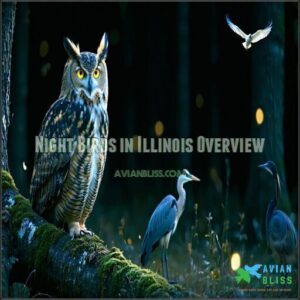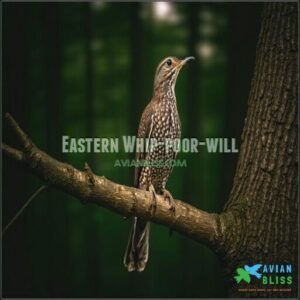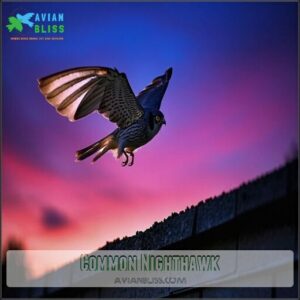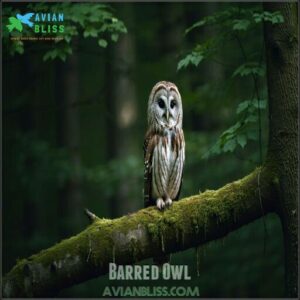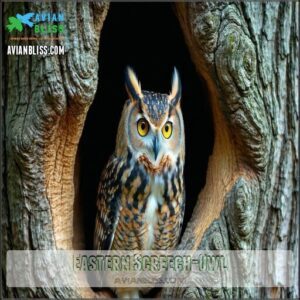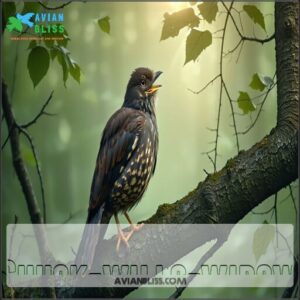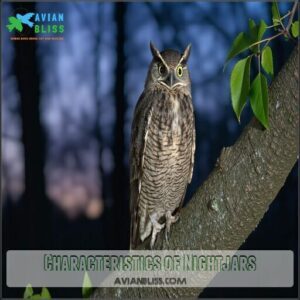This site is supported by our readers. We may earn a commission, at no cost to you, if you purchase through links.
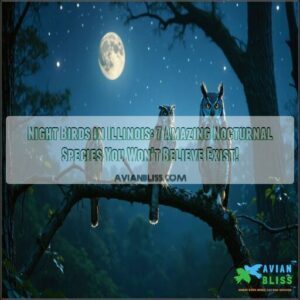 If you’re curious about night birds in Illinois, you’ve got plenty to discover!
If you’re curious about night birds in Illinois, you’ve got plenty to discover!
Species like the Eastern Whip-poor-will and Chuck-will’s-widow enchant the night with their calls, while owls such as the Barred Owl and Eastern Screech-Owl silently patrol the woods.
You might even spot a Common Nighthawk swooping through the twilight sky in search of insects.
These nocturnal birds thrive in forests, grasslands, and urban areas, though challenges like habitat loss and light pollution threaten their survival.
Each plays a pivotal role in balancing ecosystems, from controlling pests to spreading seeds, and this is a pivotal role.
Stick around—there’s so much more to learn!
Table Of Contents
- Key Takeaways
- Night Birds in Illinois Overview
- Common Night Birds in Illinois
- Nocturnal Bird Species Found in Illinois
- Threats to Night Birds in Illinois
- Getting Involved in Night Bird Conservation
- Frequently Asked Questions (FAQs)
- What is a nocturnal bird in Illinois?
- What birds live in Illinois?
- How do you know if a bird is in Illinois?
- How do birds kill a bird at night?
- What birds come out at night in Illinois?
- Where can I go bird watching in Illinois?
- Do birds fly at night?
- What kind of birds come out at night?
- What does it mean if you hear birds chirping at night?
- What animals come out at night in Illinois?
- Conclusion
Key Takeaways
- You’ll find fascinating night birds in Illinois like owls, nightjars, and herons, each playing a vital role in pest control and ecosystem balance.
- Habitat loss, light pollution, and climate change threaten these nocturnal species, making conservation efforts crucial.
- Programs like MOON let you join citizen science efforts to monitor species and support their survival.
- Simple actions like reducing light pollution and planting native vegetation can help protect these birds and their habitats, supporting ecosystem balance.
Night Birds in Illinois Overview
You’ll find thirteen species of night birds in Illinois, including owls, nightjars, and nocturnal herons that play vital roles in controlling insect populations and maintaining biodiversity.
These elusive creatures are uniquely adapted for nighttime activity with specialized vision and hearing, allowing them to navigate and hunt effectively in complete darkness, which is crucial for controlling insect populations.
Importance of Monitoring Nocturnal Birds
Regularly monitoring nocturnal birds provides critical insights that traditional surveys often miss.
Your participation in data collection efforts like MOON directly supports Illinois nocturnal bird conservation.
Here’s why monitoring matters:
- Detects subtle population trends before species reach critical decline
- Provides essential habitat quality information for conservation decisions
- Tracks nocturnal bird migration patterns across Illinois
- Enables citizen science contributions to long-term research
Without consistent monitoring, these elusive species could face undetected threats. Each observation you report helps researchers understand these mysterious nighttime flyers, ultimately ensuring their continued presence in Illinois ecosystems, which is crucial for nocturnal bird conservation and supports long-term research and citizen science efforts.
Challenges Facing Owls and Nightjars in Illinois
The silent struggle of Illinois owls and nightjars unfolds in our changing landscapes.
Agricultural dominance has dramatically limited habitat selection for these nocturnal birds. As farmlands expand, both widespread owls and species found in low numbers face mounting challenges.
Changes in agricultural practices have caused a significant food source reduction, particularly impacting species like the Chuck-will’s-widow.
- Illinois nightjars battle habitat loss as forests give way to croplands
- Light pollution disrupts migration patterns and confuses nighttime navigation
- Species endangerment accelerates with Barn Owl and Short-eared Owl already listed as endangered
- Urban sprawl eliminates essential nesting spaces for both common and rare species
- Conservation efforts struggle against the shrinking availability of suitable hunting grounds
These birds, once masters of the night sky, now face an uncertain future as human impact continues to transform their home, leaving essential ecosystems at risk.
Conservation Status of Night Birds in Illinois
The preservation of Illinois’ night birds hangs in a delicate balance, with several species facing serious conservation challenges.
You’ll find that many nocturnal birds in the state are currently listed on the Illinois Endangered Species List, including the Barn Owl and Black-crowned Night Heron, despite the latter being classified as "least concern" globally.
Key threats to these remarkable creatures include:
- Habitat loss and fragmentation from agriculture and urban development
- Light pollution disrupting natural behaviors and navigation
- Climate impacts altering migration patterns and food availability
Conservation efforts focus on protecting critical nesting sites, like the Lincoln Park Zoo rookery—the only known Black-crowned Night Heron colony in Illinois.
Pesticide use also threatens these raptors.
Monitoring programs such as MOON (Monitoring of Owls and Nightjars) track population trends, while researchers study movement patterns to develop effective protection strategies for these vulnerable species.
Common Night Birds in Illinois
You’ll find thirteen species of night birds in Illinois, including owls, nightjars, and herons that contribute to essential insect control and ecosystem balance.
Illinois hosts year-round residents like the Great Horned Owl and Barred Owl, as well as seasonal visitors such as the Eastern Whip-poor-will and Common Nighthawk, each identified by their distinctive calls and nocturnal behaviors.
Eastern Whip-poor-will
The Eastern Whip-poor-will lurks within the shadowy forests of Illinois, enchanting listeners with its haunting nocturnal song.
You’ll rarely spot these masters of camouflage techniques during daylight as they blend perfectly against forest floors. At dusk, they emerge to hunt their insectivore diet with silent precision.
These birds are best surveyed during crepuscular listening hours to accurately track their populations.
| Characteristic | Detail | Conservation Status |
|---|---|---|
| Habitat Preference | Deciduous woodlands | Declining |
| Identification | Three-syllable call | Threatened |
| Feeding Behavior | Aerial insect capture | Population decline |
| Active Season | Summer breeding | Monitoring needed |
Common Nighthawk
While the Whip-poor-will calls from forest edges, the Common Nighthawk puts on aerial displays above Illinois towns and cities.
You’ll recognize these nightjars by their erratic flight and distinctive white comma-shaped wing markings.
- Listen for their sharp "peent" call while hunting at dusk
- Look for their camouflage plumage blending with gravel rooftops
- Watch for their bat-like silhouettes zigzagging against twilight skies
- Notice how they dive dramatically during courtship displays
These insectivore specialists consume thousands of insects nightly, their wide mouths perfect for nocturnal hunting across Illinois skies.
Barred Owl
As you wander through Illinois’ mature forests at dusk, the Barred Owl watches silently from above.
This medium-sized owl, with its distinctive mottled brown and white plumage, is easily identified by horizontal stripes on its wings and tail.
You’ll recognize its famous "who-cooks-for-you" call echoing through woodlands near swamps and rivers.
These nocturnal hunters excel at capturing mice, small mammals, and occasionally fish, using their exceptional hearing and silent flight to surprise prey in complete darkness.
Eastern Screech-Owl
The diminutive Eastern Screech-Owl stands among the most adaptable Illinois nocturnal birds.
You’ll find these remarkable owls in two distinct Color Morphs: reddish-brown or gray, providing perfect camouflage against tree bark.
Their impressive Urban Adaptation includes:
- Distinctive trembling "whinny" and monotone "trill" Vocalizations
- Opportunistic Diet Variation including insects, small mammals, and birds
- Flexible Nesting Habits in tree cavities or nest boxes
- Ability to thrive in suburban neighborhoods despite their small size
Chuck-wills-widow
While the Eastern Screech-Owl prefers wooded areas, the Chuck-will’s-widow takes nocturnal mystery to another level.
This State Threatened nightjar visits southern Illinois during summer months, where its namesake call – "chuck-wills-widow" – rings through forest edges. You’ll rarely spot one due to their remarkable camouflage.
- Larger cousin to the Eastern Whippoorwill with similar breeding behavior
- Requires open forests with scattered clearings for habitat requirements
- Most active at dusk when their distinctive 5-syllable call identification is easiest
- Conservation status remains concerning due to habitat loss across range
Unlike other night birds in Illinois, their wide mouths capture flying insects with incredible precision.
Nocturnal Bird Species Found in Illinois
You’ll find thirteen fascinating nocturnal bird species in Illinois, including distinctive owls, nightjars, and herons that play essential roles in controlling insect populations.
These night birds use specialized adaptations like enhanced night vision and sensitive hearing to navigate and hunt effectively in low-light conditions.
Characteristics of Nightjars
While exploring Illinois night birds, you’ll find nightjars particularly fascinating.
These remarkable creatures possess distinctive characteristics that make them perfectly adapted for nocturnal life.
| Feature | Function | Species Example |
|---|---|---|
| Wide mouth bristles | Insect catching | Eastern Whippoorwill |
| Cryptic plumage | Nightjar camouflage | Chuckwillswidow |
| Small feet | Ground nesting | Common Nighthawk |
| Large eyes | Dusk activity | All Illinois nightjars |
Their insectivore diet helps control pest populations naturally, which is an important aspect of their role in the ecosystem, making them a valuable part of the natural balance.
Identification and Habitat of Night Birds
Identifying night birds in Illinois requires understanding their distinct habitats and behaviors. These nocturnal species blend seamlessly with their surroundings using remarkable camouflage techniques.
To spot these elusive creatures:
- Learn their distinctive bird sounds – Barred Owls’ "who-cooks-for-you" calls carry through forest corridors
- Note habitat diversity – Eastern Screech-Owls prefer wooded edges while nightjars inhabit open clearings
- Recognize nesting preferences – Great Horned Owls use abandoned hawk nests or tree cavities
- Observe regional variations – Illinois’ northern counties host different species than southern regions
Night birds identification guides highlight these species’ large eyes, mottled plumage, and specialized hearing adaptations. A helpful resource is an Illinois night bird guide for visual and auditory identification, aiding in the understanding of nocturnal species and their unique characteristics.
Diet and Foraging Habits of Nocturnal Birds
After examining a night bird’s distinctive features, you’ll find their feeding habits equally fascinating.
Illinois nocturnal birds have developed remarkable hunting strategies that make them efficient night predators.
Common Nighthawks catch flying insects near streetlights, while Chuck-will’s-widows take their prey selection to another level—sometimes consuming small birds and bats.
Eastern Whip-poor-wills use their exceptionally wide mouths to capture moths and beetles mid-flight.
Owls demonstrate different nocturnal feeding strategies, hunting rodents across woods, fields, and swamps.
Scientists study their diet by examining regurgitated pellets containing undigested bones and fur.
Night birds’ hunting adaptations include:
- Silent wing feathers for undetected approaches
- Enhanced night vision for tracking movement in darkness
- Specialized hearing that pinpoints prey location
- Large mouths that function like aerial nets
- Strategic use of artificial light sources to find insects, which is a key adaptation for their survival, and they also have exceptionally wide mouths and use regurgitated pellets to study their diet, showcasing their efficient night predators capabilities and nocturnal feeding strategies.
Breeding and Mating Habits of Night Birds
From feeding to romancing, Illinois night birds showcase fascinating breeding behaviors.
You’ll hear their courtship rituals throughout spring and summer, with each species performing unique mating calls to attract partners and establish territories.
Owls typically nest in tree cavities or abandoned hawk nests, while nightjars lay eggs directly on forest floors.
Clutch sizes vary—Eastern Screech-Owls produce 4-5 eggs, while Whip-poor-wills typically lay just 2.
Nesting locations depend on habitat preference, from wooded areas to open fields.
Most night birds time their breeding seasons to coincide with peak insect activity.
Parental care differs between species, with both parents often sharing incubation duties and feeding responsibilities, which is a key aspect of their breeding behaviors and ensures the success of their courtship rituals and mating calls.
Threats to Night Birds in Illinois
You’ll find Illinois night birds facing four major challenges: habitat loss from urban expansion, confusion from light pollution, deadly collisions with structures, and disrupted patterns due to climate change.
These threats combine to shrink populations of these remarkable creatures, with species like the Chuck-will’s-widow now listed as threatened in the state.
Habitat Loss and Fragmentation
Across Illinois, habitat loss and fragmentation pose serious threats to night birds like Eastern Whip-poor-wills and Barred Owls. Once-extensive forests and prairies have been carved into disconnected patches, reducing nesting availability and creating dangerous edge effects for these nocturnal species.
When habitats shrink, these birds face:
- Decreased hunting territories, leading to significant prey reduction
- Limited nesting sites, forcing birds into less suitable areas
- Interrupted breeding patterns that threaten population stability
Forest management and bird conservation efforts are essential for Illinois wildlife. Creating habitat corridors can help reconnect fragmented landscapes, allowing night birds to move safely between remaining natural areas and sustain their populations despite ongoing development pressures.
Light Pollution and Its Effects
Beyond habitat loss, light pollution creates dangerous conditions for night birds Illinois residents often overlook.
Artificial lighting disrupts natural behaviors of nocturnal birds, causing navigation impairment and foraging disruption.
| Impact | Effect | Bird Response |
|---|---|---|
| Hunting | Reduced prey detection | Increased starvation |
| Breeding | Mating interference | Population decline |
| Migration | Disorientation | Higher mortality |
You can help by installing motion-sensor lights and drawing curtains at night, supporting bird conservation through simple physiological impacts reduction, which can lead to a significant positive change.
Collisions With Cars and Buildings
Silently flying through Illinois skies, nocturnal birds face deadly hazards from human structures. Chicago alone reported nearly 1,000 birds dying in a single night from window collisions at McCormick Place.
These bird strikes occur at both skyscrapers and homes, with 44% happening at residential buildings. Building design modifications like patterned glass and bird deterrents can reduce casualties by 60%.
Illinois’ Bird Safe Buildings Act (2021) now requires urban planning to incorporate bird-friendly features in state buildings. Light mitigation through drawn curtains and dimmed nighttime illumination substantially decreases collisions, making rescue efforts more effective.
Climate Change and Its Impact on Nocturnal Birds
Climate change is rewriting the rules for night birds in Illinois.
Rising temperatures and shifting habitats challenge Illinois’ night birds, pushing them to adapt to an ever-changing environment.
Rising temperatures and shifting weather patterns trigger migration shifts, breeding disruptions, and habitat alteration, leaving nocturnal birds struggling to adapt. Species like the Eastern Whip-poor-will and Common Nighthawk face food scarcity as ecosystems change, and extreme weather events further threaten their survival. Even natural instincts, like bird migration timing, are thrown off by unpredictable conditions.
- Habitat alteration reduces safe nesting and foraging spaces.
- Food scarcity impacts insect-eating nocturnal birds as prey populations decline.
- Extreme weather disrupts breeding cycles and damages habitats.
Conservation efforts are essential to protect Illinois’ nocturnal birds.
Getting Involved in Night Bird Conservation
You can play a pivotal role in protecting Illinois’ night birds by joining conservation efforts that monitor their populations and habitats.
Participating in programs like MOON helps gather essential data to guarantee these fascinating species thrive for generations, which is crucial for their conservation.
Illinois Night Bird Monitoring Program
The Illinois Night Bird Monitoring Program, known as MOON, is your chance to plunge into the fascinating world of nocturnal birds.
From April to June, volunteers walk 9-mile routes, stopping at 10 points to listen for distinctive bird sounds like the hoots of owls or the calls of nightjars.
This bird monitoring effort gathers vital data for species tracking and bird conservation, guiding habitat preservation strategies.
By participating, you’ll help expand the program’s reach, support data analysis, and raise public awareness about these elusive creatures.
It’s a rewarding way to protect night birds in Illinois while experiencing the magic of their nighttime symphony.
How to Participate in The Monitoring Program
Interested in bird monitoring? Join the MOON Citizen Science program to help track night birds like owls and nightjars.
Volunteers follow designated monitoring routes from April to June, listening for unique calls and recording data. No expertise? No problem! You’ll learn species identification and data collection skills.
Choose a route selection that suits you, grab simple gear like a flashlight and notebook, and start observing. Products are available to support your involvement.
Afterward, submit your findings to support conservation. It’s a hands-on way to enjoy nature while protecting Illinois’ nocturnal bird populations. Ready to make a difference?
Conservation Efforts for Night Birds in Illinois
Protecting night birds in Illinois starts with Habitat Restoration and Light Reduction.
Restoring breeding areas and shielding outdoor lights can reduce disruptions to bird migration. Citizen Science programs like MOON empower you to track species trends, while Policy Changes guarantee sustainable development near natural habitats.
Education Outreach spreads awareness about the importance of bird habitat conservation. Using bird-friendly lighting options can substantially help reduce light pollution’s impact.
By supporting bird conservation efforts, you’re helping these nocturnal species thrive, guaranteeing Illinois’ ecosystems remain balanced and vibrant for future generations, which is crucial for sustainable development and balanced ecosystems.
Ways to Support Night Bird Conservation
Supporting night birds conservation in Illinois starts with small, impactful changes.
Transform your yard into a haven for these fascinating creatures:
- Reduce Pesticides: Protect the insects night birds rely on for food.
- Native Plantings: Grow local trees and shrubs to offer shelter and natural diets.
- Responsible Lighting: Install bird-friendly lights to cut light pollution.
- Citizen Science: Join programs like the Illinois Night Bird Monitoring Program to track species.
These steps promote habitat restoration and help preserve the delicate balance night birds bring to Illinois ecosystems.
Consider participating in bird conservation volunteer work to further support these efforts.
Small actions make a big difference!
Frequently Asked Questions (FAQs)
What is a nocturnal bird in Illinois?
A nocturnal bird in Illinois is the Great Horned Owl.
You’ll recognize it by its deep hoots, large yellow eyes, and ear tufts.
It hunts silently at night, thriving in forests and urban areas.
What birds live in Illinois?
Illinois is home to a diverse range of birds, including robins, cardinals, sparrows, hawks, and owls.
You’ll also find seasonal visitors like warblers and waterfowl, thriving in forests, wetlands, and urban areas.
How do you know if a bird is in Illinois?
You’ll know a bird is in Illinois by observing its habitat, listening for unique calls, and noting behaviors.
Check local bird guides or apps to match sightings with species commonly found in the state, which will help you identify the bird.
How do birds kill a bird at night?
Ever heard the phrase "silent but deadly"?
Birds use stealth and sharp talons to ambush prey at night.
Owls, for instance, rely on incredible hearing and silent flight to swoop in undetected for a quick kill.
What birds come out at night in Illinois?
You’ll spot Great Horned Owls, Barred Owls, and Eastern Screech-Owls hunting silently.
Nightjars like Common Nighthawks and Whip-poor-wills sing distinct calls.
Black-crowned Night-Herons forage near wetlands, while Northern Mockingbirds serenade under moonlight.
Where can I go bird watching in Illinois?
Check out Illinois hotspots like the Cache River State Natural Area, Starved Rock State Park, and Midewin National Tallgrass Prairie.
These spots offer diverse habitats, perfect for spotting unique birds during dawn, dusk, or nighttime excursions, which provide a great opportunity to see unique birds.
Do birds fly at night?
Yes, many birds fly at night, especially migratory species like warblers and thrushes.
They use the stars for navigation, avoid predators, and conserve energy in cooler air, making nighttime the perfect time for long journeys, utilizing the stars for guidance.
What kind of birds come out at night?
When the stars take the stage, nocturnal birds like owls, nightjars, and herons emerge.
You’ll hear Great Horned Owls hoot, Eastern Whip-poor-wills sing, and Black-crowned Night-Herons forage, showcasing nature’s nighttime symphony.
What does it mean if you hear birds chirping at night?
Hearing birds chirping at night often means they’re marking territory, attracting mates, or responding to light pollution.
Species like mockingbirds and chats are known for nocturnal singing, especially during breeding seasons or in urban areas.
What animals come out at night in Illinois?
At night in Illinois, you’ll find nocturnal animals like raccoons, opossums, skunks, coyotes, bats, and deer.
Amphibians like frogs and nocturnal insects also emerge, along with owls and other night birds active during low light.
Conclusion
Before Netflix binges, nature’s night show starred the fascinating night birds in Illinois.
These nocturnal species, like the Eastern Whip-poor-will and Barred Owl, play essential roles in pest control and seed dispersal, keeping ecosystems balanced.
However, threats like habitat loss and light pollution challenge their survival.
By learning more, joining conservation efforts, or simply reducing outdoor lighting, you can help protect these incredible birds.
Explore the night skies—they’re full of life waiting to be discovered!

